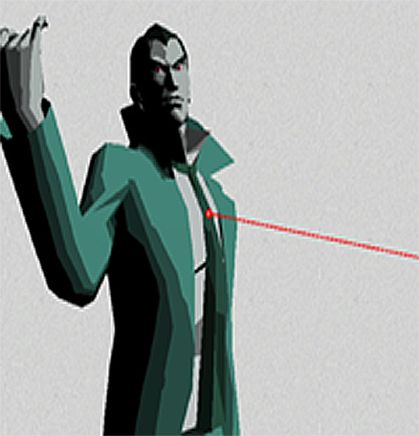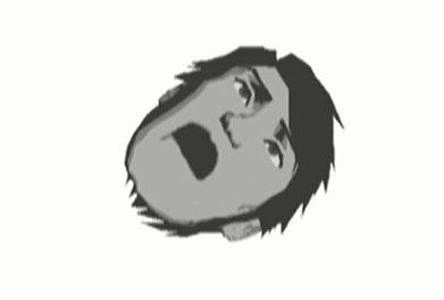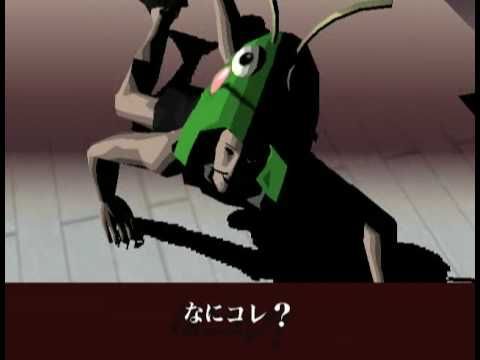While I'm currently a PC gamer, I used to be a console enthusiast, especially for Nintendo. And while I loved Super Mario 64, Banjo Kazooie, and Super Smash Brothers, the GameCube's always been special to me. While it lost out to the far more flexible Playstation 2 and fledgling Xbox, it still possessed an excellent library of games. Thanks to the Wii's backwards compatibility, I continued playing GameCube games far past its lifespan, managing to unearth several obscure gems, my favorite being Suda51's magnum opus, Killer7.
I got my first taste of Goichi Suda's madness in No More Heroes for the Wii. I talk more about it in my review of it here. This hack n'slash starring a lightsaber-wielding otaku assassin enticed me to track down his first major title.
Killer7 beats No More Heroes on every level, combining multiple game and cinematic genres into a unique, unforgettable experience, making it one of my favorite games.
Wheelchair-bound demigod Harman Smith is the world's most preeminent assassin, commanding the Smith Syndicate. While there are seven characters who make up the organization, Harman is, in fact, all of them, having the ability to shift into each persona according to any situation. The killers possess their own individual abilities and personalities that make them all equally lethal and entertaining, including the super shot firing Dan, sniper Kaede, silent knife-wielder Kevin, speedster Con, master thief Coyote, luchador Mask, and cleaner Garcien. The Smiths work for the United States government to hunt down the Heaven Smiles, eerie laughing suicide bombers commanded by the immortal Kun Lan.
 |
| Notice the popped collar. Pinnacle of cool. |
The player will run across various NPCs, former targets dispatched by Harman and the Syndicate. They provide ample hints for puzzle sections and vague clues of the plot's true nature.
Killer7 uses an on-rail system of movement, making the character move in a third-person view by holding the A button and making them turn around by hitting B. When the player hits a crossroads, they can use the control stick to choose their path. Holding the R button transfers to a first-person combat view to take on the Smiles. However, they initially appear invisible, solely discernible from their creepy laughs. Smith has the ability to scan and expose them, allowing him to kill them first.
Scanning also reveals "critical" spots that causes Smith to harvest blood from the enemy. There are two types of blood that the player can obtain: thin and thick. While thin can be used to heal or perform special abilities, thick blood can be converted to a serum used for upgrading a Smith's various stats.
There's a wide variety of powerful Heaven Smiles and each Smith possesses their own advantages and disadvantages when dealing with them. Fortunately, if a Smith is killed, Garcien has the ability to recover and even revive their corpses, though this may require some backtracking. However, if Garcien is killed, then it's game over!
 |
| Very Japanese. |
Developer Suda51 loves to use cel-shaded graphics to create a nearly cartoonish style, reminiscent of anime. Cutscenes usually implement the in-game engine, but several during the middle of the game actually experiment with different animation styles, namely Western and Japanese animation respectively.
The soundtrack mixes the surreal and atmospheric with techno rave and mellow acoustic guitar with heavy rock. Overall, it's a blend that appropriately suits each scenario. Sound effects, though repetitive, never gets old, especially the laughter of the Smiles and the Smith execution lines.
Killer7's storytelling is episodic with the initial levels acting as a broad introduction to the world and characters and later stages expanding on them with new assassination targets linked to Heaven Smile. Some missions are even enhanced by animated cutscenes rendered in different anime styles! Two unlockable game modes extend the game's already high replay value: Killer8, a new, much higher difficulty setting and Hopper7, an easy version of the first level with the Heaven Smiles being replaced by grasshopper men, a joke based on Suda's Grasshopper Manufacture studio.
The game has many complex layers and somehow manages to wrap up most loose threads, though these answers can be equally confusing as the initial questions. Suda's heavy use of symbolism outlines a kind of East VS West dynamic. While the villains are Japan's nationalistic U.N. Party and the Heaven Smile progenitor Kun Lan, Harman Smith and the Killer7 are assassins for the United States government. However, despite their enmity, Harman and Kun Lan are amicable enough to regularly play chess matches to determine the fate of the world.
 |
| WTF?! |
The game has many complex layers and somehow manages to wrap up most loose threads, though these answers can be equally confusing as the initial questions. Suda's heavy use of symbolism outlines a kind of East VS West dynamic. While the villains are Japan's nationalistic U.N. Party and the Heaven Smile progenitor Kun Lan, Harman Smith and the Killer7 are assassins for the United States government. However, despite their enmity, Harman and Kun Lan are amicable enough to regularly play chess matches to determine the fate of the world.
Killer7 is a very "artsy" game. It delves into very mature philosophical issues, exploring issues of post-war Japan's vulnerability, prospects of utopian and dystopian societies, and even touching on terrorism and organ trafficking. However, despite its serious features, it's filled to the brim with zany pop culture references, snazzy one liners, flashy executions, supernatural abilities, and disjointed atmosphere. Despite being so complex, it's still a damn fun game that knows how to keep its audience entertained (albeit often perplexed) and prevent the action from feeling stale. It's an experience that warrants a plethora of in-depth interpretations, all of which bear equal credibility.
Suda51 knows how to create memorable games. Perhaps they aren't as fluid or polished as more mainstream titles, but they exhibit his passion for Japanese pop culture, lucha libre, American cinema, etc. Passion may never produce a perfect diamond, but Suda is really close with this title, making it my favorite of his oeuvre.
----------------------
Thanks for reading! For those of you who've either played the game or do not wish to, but are interested in his games, check out my spoiler-filled attempt at explaining the game on Sunday. I hope you read it too!


No comments:
Post a Comment